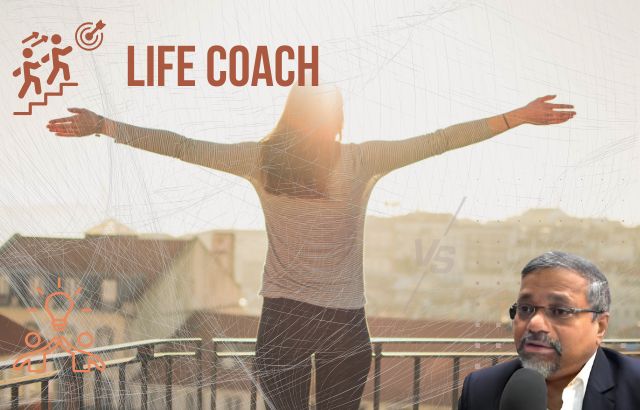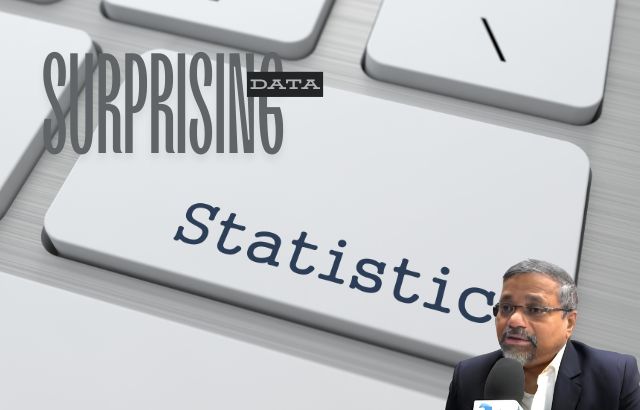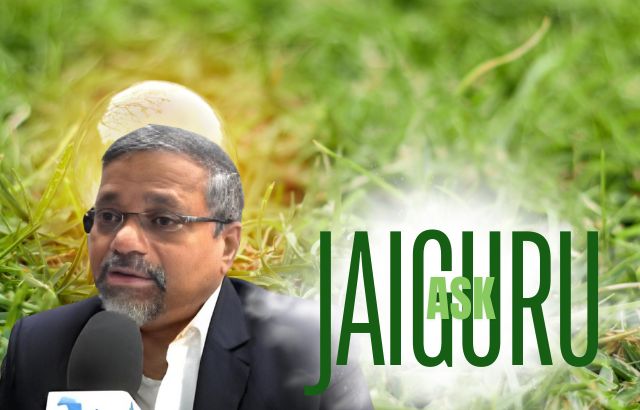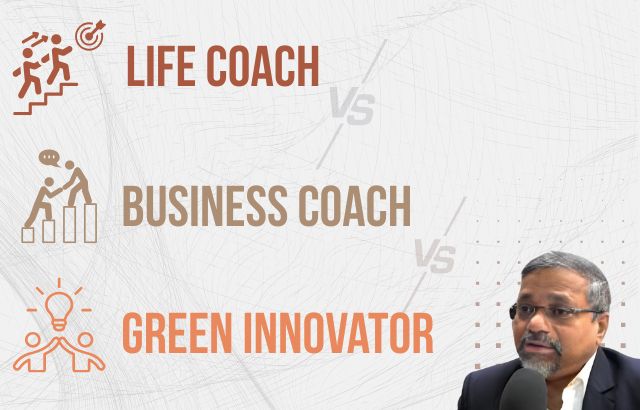In today’s fast-evolving world, professionals like life coaches, business coaches, and green innovators play pivotal roles in guiding individuals, organizations, and industries toward success and sustainability. Each has a distinct focus—personal growth, business performance, or environmental impact—but all share a commitment to transformation. This blog compares life coaches, business coaches, and green innovators, provides real-world examples, details the roles of Green Innovators, and shares insights from Agriculture Green Innovator Jaiguru Kadam, including calculations and intriguing statistics. We also address frequently asked questions to clarify their unique contributions.
Understanding the Roles
Life Coach

A life coach helps individuals achieve personal goals, improve well-being, and navigate life transitions. They focus on areas like relationships, career changes, self-confidence, and work-life balance, using tools like goal-setting, mindfulness, and accountability strategies.
- Example: Tony Robbins, a renowned life coach, has empowered millions through seminars and books like Awaken the Giant Within, helping clients overcome limiting beliefs and achieve personal breakthroughs.
- Key Focus: Holistic personal development, emotional resilience, and life satisfaction.
Business Coach

A business coach works with entrepreneurs, executives, and teams to enhance business performance, leadership skills, and strategic growth. They provide guidance on marketing, financial planning, team management, and scaling operations.
- Example: Anese Cavanaugh, a business coach, helps leaders at companies like Google and Microsoft develop authentic leadership and improve workplace culture through her IEP (Intentional Energetic Presence) methodology.
- Key Focus: Organizational success, profitability, and leadership development.
Green Innovator
A Green Innovator drives sustainability by developing eco-friendly solutions, particularly in industries like agriculture, energy, and manufacturing. They integrate technology, advocate for sustainable practices, and address environmental challenges, often in agriculture or green technology sectors.
- Example: Vandana Shiva, an Indian environmentalist, promotes sustainable agriculture through her organization Navdanya, advocating for organic farming and seed sovereignty to protect biodiversity.
- Key Focus: Environmental sustainability, resource efficiency, and community impact.
Comparing Their Approaches
| Aspect | Life Coach | Business Coach | Green Innovator |
|---|---|---|---|
| Primary Focus | Personal growth and well-being | Business growth and leadership | Environmental and social impact |
| Target Audience | Individuals seeking life changes | Entrepreneurs, executives, teams | Farmers, industries, communities |
| Tools/Methods | Coaching sessions, mindfulness | Strategic planning, analytics | Technology, sustainable practices |
| Outcome | Improved life satisfaction | Increased revenue, efficiency | Reduced ecological footprint |
| Timeframe | Short to long-term personal goals | Short to medium-term business goals | Long-term systemic change |
The Role of a Green Innovator
A Green Innovator is a visionary who combines creativity, technology, and sustainability to solve environmental problems. In agriculture, they focus on reducing waste, improving resource efficiency, and promoting eco-friendly practices. Their roles include:
- Technology Development: Creating tools like solar-powered equipment or bio-pesticides to minimize environmental impact.
- Sustainable Advocacy: Promoting practices like organic farming, water conservation, and renewable energy use.
- Community Engagement: Educating farmers and stakeholders on sustainable methods through workshops and demonstrations.
- Economic Analysis: Designing cost-effective solutions to make green technologies accessible to smallholder farmers and industries.
Green Innovators bridge the gap between environmental goals and practical implementation, driving systemic change for a sustainable future.
Insights from Jaiguru Kadam, Agriculture Green Innovator
Jaiguru Kadam, a leading Agriculture Green Innovator from India, has pioneered sustainable agricultural solutions, making farming more efficient and eco-friendly. Below are two calculations by Kadam that highlight the financial and environmental benefits of green innovation in agriculture.
Calculation 1: Cost-Benefit Analysis of a Solar-Powered Irrigation System
- Setup Cost:
- Solar panels and pump: $3,000
- Installation: $500
- Piping and fittings: $700
- Total: $4,200
- Annual Revenue:
- Crop: Rice (additional yield due to reliable irrigation: 2,000 kg/year)
- Market price: $0.5/kg
- Revenue: 2,000 kg × $0.5 = $1,000
- Annual Operating Costs:
- Maintenance: $200
- Total: $200
- Net Profit: $1,000 – $200 = $800
- Break-Even Period: $4,200 ÷ $800 ≈ 5.25 years
Kadam’s solar-powered irrigation system enables farmers to recover costs within six years while reducing reliance on fossil fuels.
Calculation 2: Environmental Impact of Organic vs. Chemical Fertilizers
- Chemical Fertilizer Use:
- Application: 1,000 kg/year on a 5-hectare farm
- Soil degradation: 1,000 kg × 0.2 kg nutrient loss/kg = 200 kg/year
- CO2 emissions: 1,000 kg × 1.5 kg CO2/kg = 1,500 kg CO2/year
- Organic Fertilizer Use:
- Application: 1,000 kg/year (compost-based)
- Soil degradation: Negligible
- CO2 emissions: 1,000 kg × 0.3 kg CO2/kg = 300 kg CO2/year
- Annual Savings:
- Nutrient loss reduction: 200 kg – 0 kg = 200 kg
- CO2 reduction: 1,500 kg – 300 kg = 1,200 kg CO2/year
Kadam’s organic fertilizer approach preserves soil health and significantly cuts emissions, promoting sustainable farming.
Surprising Statistics

- Coaching Industry: The global coaching market was valued at $15 billion in 2023, with life coaching accounting for 40% and business coaching 35%.
- Green Innovation: Sustainable agriculture practices could reduce global agricultural emissions by 20% by 2030.
- Impact of Coaching: 80% of clients report improved self-confidence after life coaching, while 70% of businesses see revenue growth after business coaching.
- Environmental Gains: Green innovations in agriculture have reduced water usage by 30% in some regions through precision irrigation.
- Adoption Challenges: Only 25% of smallholder farmers in developing countries adopt green technologies due to cost and awareness barriers.
FAQs About Life Coaches, Business Coaches, and Green Innovators

Q1: How do I choose between a life coach, business coach, or green innovator?
A: Choose a life coach for personal growth, a business coach for professional or organizational goals, and a green innovator for sustainable projects or environmental impact.
Q2: What qualifications do these professionals need?
A: Life and business coaches often have certifications from bodies like the ICF, while green innovators may have degrees in agriculture, engineering, or environmental science, plus practical experience.
Q3: Can a green innovator help small businesses?
A: Yes, green innovators can design sustainable practices, like energy-efficient processes, to reduce costs and enhance a business’s eco-friendly reputation.
Q4: How long does it take to see results from coaching or innovation?
A: Life coaching results can appear in weeks to months, business coaching in months to a year, and green innovations may take years for systemic impact but offer immediate cost savings.
Q5: Are these services affordable for individuals or small farmers?
A: Life and business coaching costs vary ($50–$500/hour), but group programs are cheaper. Green innovators like Kadam create low-cost solutions, and subsidies often support farmers.
Conclusion
Life coaches, business coaches, and green innovators each play unique roles in fostering personal, professional, and environmental transformation. From Tony Robbins’ personal empowerment to Grant Cardone’s business scaling and Vandana Shiva’s sustainable agriculture, their impact is profound. Green Innovators like Jaiguru Kadam stand out by addressing global challenges with practical, eco-friendly solutions, as shown through their insightful calculations. As the demand for coaching and sustainability grows, these professionals offer invaluable guidance for individuals, businesses, and communities striving for a better, greener future.












